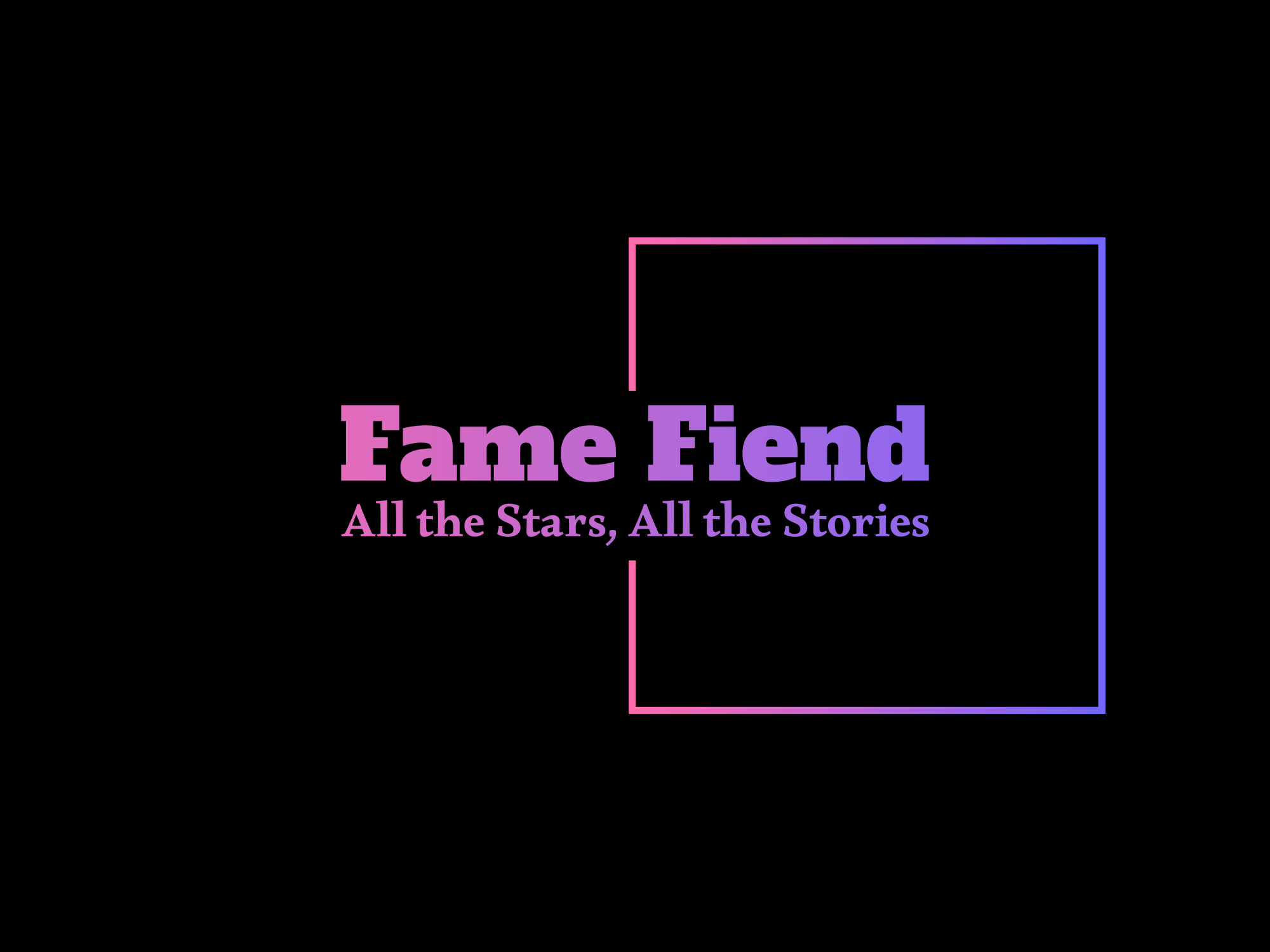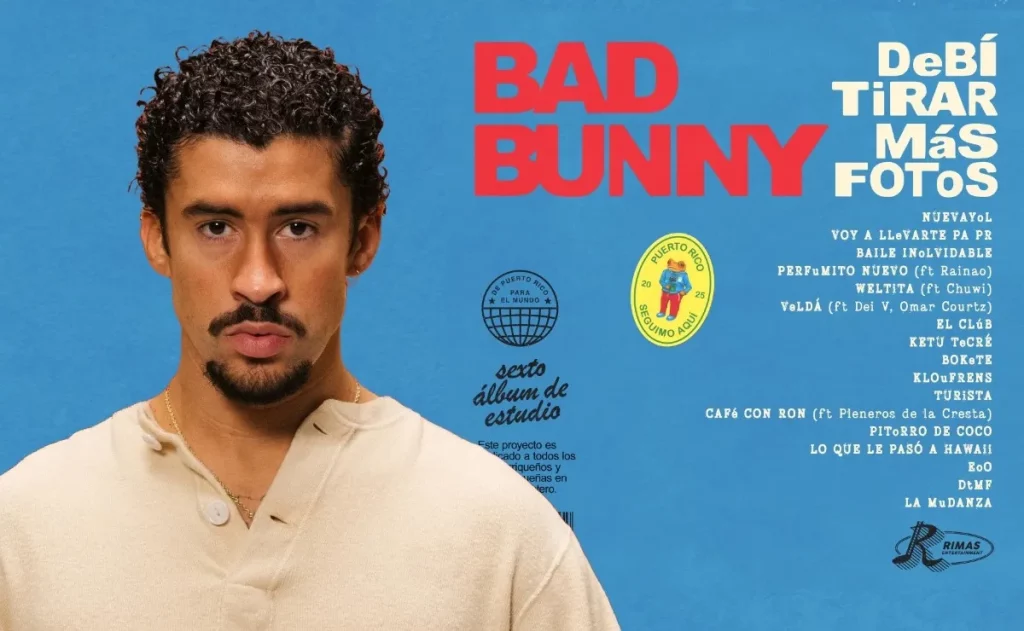On January 5th, Bad Bunny released his sixth studio album, DeBÍ TiRAR MáS FOToS (I should have taken more photos). By now, you will find no shortage of reviews and/or social media posts about the album, which at the time of writing this, is number one on the U.S. Billboard charts, surpassing Taylor Swift. DtMF is an ode to all things Puerto Rico. It serves as an oral history; a culmination of all things that have happened to the archipelago and its people. Through combining salsa, reggaeton, plena and bomba, it honors all the musical genres of Puerto Rican culture, while blending it with other sounds of música urbana. Lyrics on DtMF acknowledge Puerto Rican figures from activist Eugenio María de Hostos to rapper Big Pun, as well as the history of colonization and its effects on the island. It’s a tribute to all of the generations before, while creating space for those to come. The result is both old and new; it is the past and the future. It is tradition and innovation.
From the moment I first pressed play on this album, I couldn’t stop thinking about movies that perfectly complement it. And if you’re like me, you understand the world through movies. The following list has something for everyone – documentaries, a concert film, an animated short, feature length narratives and even a docuseries – all in harmony with themes from DtMF.
So, here is a suggested watch list to complement the expansive, very Puerto Rican experience that is DeBÍ TiRAR MáS FOToS:
1. “Our Latin Thing (Nuestra Cosa)” (Leon Gast, 1972)
The album’s first track, “NUEVAYoL,” is a tribute to the diaspora of Puerto Ricans in New York who are so vital to the culture that they designed the version of the Puerto Rican flag used today. Another New York invention? Salsa music. The opening seconds of “NUEVAYoL” conjures a sample of the legendary salsa band El Gran Combo de Puerto Rico, which inspired me to think about “Our Latin Thing (Nuestra Cosa).”
What Motown is to soul music, Fania is to Salsa. “Our Latin Thing (Nuestra Cosa),” a seminal concert documentary with an all-star lineup of salsa legends playing a show at the Cheetah Club in 1971, is a must watch for anyone into NYC history and music history. Concert footage is interspersed with scenes of a 1970s Lower East Side. Children play on rooftops, run through alleyways and play percussion instruments while sitting on scaffolding. Concert footage also shows the crowd dancing to salsa, sweat dripping down their bodies while moving to performances by Ray Barretto, Willie Colón, Héctor LaVoe, Ismael Miranda, José ‘Cheo’ Feliciano, and more. This enjoyable time capsule of Latino New York City is for anyone who loves concert movies like “Summer of Soul,” “Dave Chappelle’s Block Party,” or “Stop Making Sense.” (Available on YouTube)
2. “Los Sures” (Diego Echeverria, 1984) / Living Los Sures (Various, 2014)
In “NUEVAYoL,” Bad Bunny makes reference to South Williamsburg legend Toñita, owner of Caribbean Social Club, the last of its kind in the area. More commonly referred to as Los Sures by its inhabitants in the 1980s, South Williamsburg was once a forgotten neighborhood where most of its residents lived below the poverty line. In 1984, the documentary “Los Sures” captured the lives of families and community members of the area in what has become one of the staple artifacts of pre-gentrification New York history.
Decades later in 2014, UnionDocs embarked on a massive project: “Living Los Sures.” The release includes a restoration of the original documentary along with 40 short films inspired by the neighborhood, an interactive follow-up documentary on one of the subjects of “Los Sures,” and a compilation of oral histories based on each shot of the film. The utterly expansive, in-depth approach and dedication to preserving history this project achieves is reminiscent of the intentions taken by Bad Bunny and his team to show Puerto Rican history not just through the music, but also through the visual aids provided for each song, written by historian and professor Jorell Meléndez-Badillo. (Available for Rent on most major platforms)
3. “Lo que le Pasó a Santiago (What Happened to Santiago)” (Jacobo Morales, 1989)
So far, three music videos and one short film have been released to accompany DtMF. Two of them feature 90-year-old filmmaker/actor Jacobo Morales, who directed “Lo que le Pasó a Santiago,” the only Puerto Rican movie ever nominated for an Academy Award for best foreign language film (and possibly the last, since Puerto Rico, or any other U.S. territory, stopped being eligible to qualify for a foreign language Oscar in 2011).
In the DtMF short film, Jacobo speaks with Concho, a Puerto Rican crested toad, about the passage of time. Both Jacobo and Concho are endangered species, longing for the Puerto Rico they used to know. And in the music video for “BAILE INoLVIDABLE,” Jacobo signs up for salsa lessons. These themes of past and present are both solemn and hopeful, which is similar to the challenges faced by protagonist Santiago in Morales’ own film “Lo que le Pasó a Santiago,” as the titular widower struggles to overcome feelings of solitude after being pressured to retire from his job. (Available on Internet Archive)
4. “La Pecera (The Fishbowl)” (Glorimar Marrero Sánchez, 2022)
Glorimar Marrero Sánchez directs this somber yet beautiful film about a woman named Noelia who returns to her homeland on the island of Vieques, whose community is still feeling the environmental effects of U.S. military bombing from decades prior. Noelia, suffering from cancer, grapples with her mortality while also dealing with the lasting effects of U.S. colonization that have embedded every fiber of everyday life in Vieques. This movie will resonate deeply with anyone who loves the song “LO QUE LE PASÓ A HAWAii (What Happened to Hawaii),” a haunting vow to fight for the autonomy of one’s homeland. (Available on Filmin with Subscription)
5. “¡Yo Soy Boricua, Pa’Que lo tu Sepas!” (I’m Puerto Rican, Just So You Know!) (Rosie Perez and Liz Garbus, 2006)
The visualizer for the song WELTiTA details Christopher Columbus’ arrival to Borikén, the Spaniards’ violent takeover of the land, and the bravery of the indigenous people who fought back. This rarely taught history is also covered in this 2006 documentary co-directed by Rosie Perez. Through family and expert testimonies, and narrated by Jimmy Smits, “¡Yo Soy Boricua Pa’Que lo tu Sepas!” ranges in topics like the history of Puerto Rico’s aforementioned indigenous Taino tribe and Spanish/American colonization, to more casual questions like: Why are Puerto Ricans so damn proud? (Available on YouTube)
6. “Reggaeton: The Sound that Conquered the World”
This four-episode docuseries details Reggaeton’s beginnings from when it was referred to only as “Underground,” and explains its sonic influences from Africa, Jamaica, Panama, and New York’s hip-hop scene to create the hit-making fusion of rap, salsa, and reggae. Using a mixture of archival footage and interviews with major contributors to the genre including Daddy Yankee, Ivy Queen, Tego Calderon, and Bad Bunny himself, “Reggaeton: The Sound that Conquered the World” gives us first-hand accounts of moments that created this global phenomenon. In one such moment, we see footage of an unknown Daddy Yankee performing at a club in crutches, still recovering from a gunshot wound in his leg, with infectious energy matched by the crowd. His worldwide hit “Gasolina” wouldn’t even be released until a decade later, so much of the footage in this series feels prescient. (Available on Peacock)
7. “Nuevo Rico” (Kristian Mercado, 2021)
“Nuevo Rico” is an animated short film about a brother-sister reggaeton duo who steal from Taino gods to gain stardom in the music world and eventually have to pay the price. The grainy, vaporwave-inspired look evokes an ‘80s feel that contributes to an aesthetically and sonically vibrant tribute to Reggaeton and Puerto Rico. (Available to watch on the official site)
8. “Melting Snow” (Janah Elise Cox, 2021)
This short film comprised of archival footage from 1952, “Melting Snow” documents when Eastern Airlines partnered with the mayor of San Juan and transported two tons of snow from New Hampshire to Puerto Rico so locals “could experience a ‘White Christmas” – but there was an unfair exchange in cargo. After the snow was unloaded for children to play in, those same planes left full of Puerto Ricans who would provide cheap labor for workforces on the U.S. Mainland, which is one of many deeply unsettling juxtaposed scenes in this 9 minute short. From the eerie, foreboding score, to the voice of Pedro Pietri reciting his famed poem “Puerto Rican Obituary,” to more recent footage recorded during Hurricane Maria, “Melting Snow” results in a powerful visual commentary on U.S. Imperialism’s effects on a culture, especially when paternalistic actions are framed as “favors.” (Available on Criterion Channel)
9. “Aquí” (Carlos Mario, 2020)
“Aquí” takes place during the mass protests that happened in Puerto Rico in 2019 where the public demanded the resignation of then-Governor Ricardo Rosselló. Protestors play plena and bomba, forms of music passed down from enslaved African ancestors, as a call for liberation. These sounds can be heard throughout DtMF, but most notably on “CAFé CON RON,” a song featuring Los Pleneros de la Cresta, a band initially formed to teach youth how to play Plena music. “Aquí” is a brief glimpse into the power of protests, and how even moments of celebration can be acts of resistance. (Available on Criterion Channel)
10. “Puerto Rico: A Colony the American Way” (Diego Echeverría, 1982)
This newsreel-like documentary from 1982 details the dire economic, political, and social situations faced by the archipelago, mostly due to the United States’ treatment of it as a place to extract goods, land, and inexpensive labor. In the words of filmmaker and narrator Diego Echeverria, Puerto Rico “has been forced to grow beneath an artificial sun – that of the American dollar.”
The 27-minute report begins with coverage of the 1980 election, where Puerto Ricans could not (and still can’t) vote for the U.S. President, but could vote for their governor. The topic of Statehood versus Independence was prominent in that election, much like the most recent one that occurred this past November, in which Bad Bunny was a vocal supporter of the independent party. In fact, one could consider the whole album of DeBÍ TiRAR MáS FOToS to be a call for independence among Puerto Ricans; evoking a renewed sense of pride in either being directly from or having ancestral roots to the archipelago, and a reminder of the strength it took us to survive thus far. (Available on Internet Archive)

